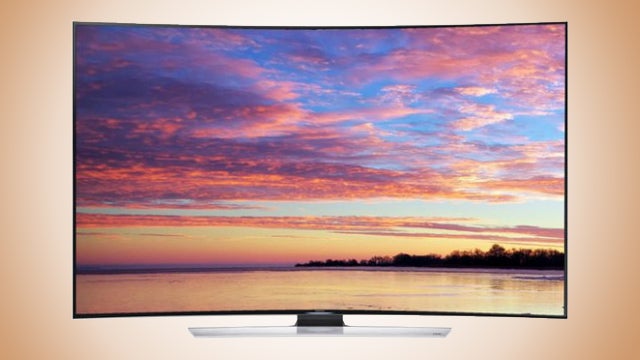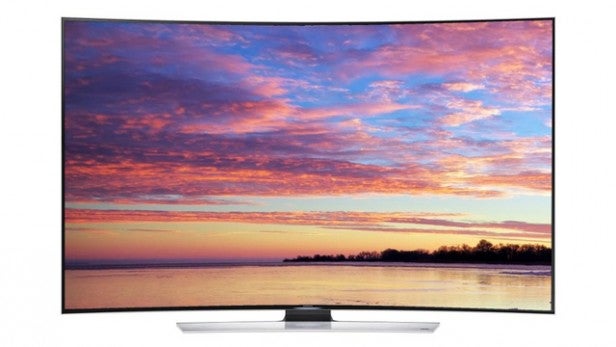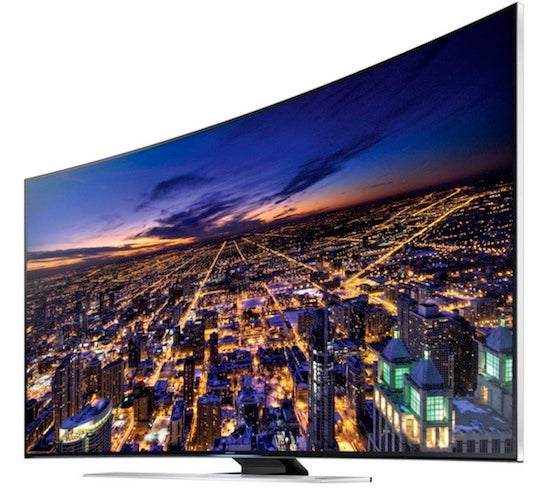Samsung UE65HU8500 Review - Set Up & Picture Quality Review
Set Up & Picture Quality
The future of TV starts here

Sections
- Page 1 Samsung UE65HU8500 Review
- Page 2 Set Up & Picture Quality Review
- Page 3 3D, Sound and Verdict Review
Samsung UE65HU8500: Set Up
As we’ve come to expect from high-end
Samsung TV sets, the UE65HU8500 provides a wealth of picture
adjustments. Among the key options to play with are a backlight
adjustment, a multi-level dynamic contrast option, a multi-level black
tone adjustment, a flesh tone slider, white balance fine tuning, a gamma
slider, normal and MPEG noise reduction, and various settings for both
Samsung’s Motion Plus motion processing option and Smart LED local
dimming engine.
Also present and correct on this 8500 series
model is Samsung’s Cinema Black feature, which lets you ‘turn off’ the
sections of edge LED lighting that correspond with the parts of the
screen occupied by black bars during viewing of 2.35:1 aspect ratio
material. This greatly reduces the distracting edge LED issue of
clouding and shifting light inconsistencies in black bars as the
backlighting self-adjusts to continually optimise itself to the
ever-changing picture.
We found with the UE65HU8500 that we needed to set the Cinema Black feature to its Medium level to get a clean result.
In
terms of other adjustments, we’d strongly suggest: turning off all
noise reduction systems when watching HD and, especially, UHD; reducing
the backlight to as low as its 9 or 8 level when watching films in a
darkened room to get the best and most cloud-free black level
performance; and making sure the backlight and contrast levels are no
higher than their 12-14 and 80-85 levels respectively.
We also
found it more or less essential to leave the Smart LED local dimming
feature set on, albeit only to its Low level, in order to get the
deepest, cleanest black level performance out of the screen.
For
reasons explained in the 3D Picture Quality section of the review,
meanwhile, we’d recommend nudging down the backlight setting for 3D
viewing to around 16, and the sharpness to between 37 and 40.
One
final thing worth mentioning to adventurous users is the UE65HU8500’s
Professional Calibration Mode. This allows you to set your TV up with a
level of precision usually only accessible to professional calibration
engineers. The system even supports a wide range of USB colour meters, including some relatively affordable ones.
One little issue
that occurred to us during set up was that it might have been nice if
you could defeat the depth enhancement processing Samsung has introduced
for its curved TVs. Hopefully this processing won’t, at any rate, cause
input lag issues when gaming.
Samsung UE65HU8500: Picture Quality
Samsung’s top-level TVs have delivered pretty stellar picture results for the past few generations now, so expectations are sky-high for the UE65HU8500. And it’s obvious pretty much immediately that it’s not going to let us down – curve or no curve.
Feeling a bit stroppy about the fact that still nobody has got their bottoms in gear and delivered an easy-to-find native UHD source (more on this later), we actually started out our tests of the UE65HU8500 by trying out its upscaling capabilities with a few Blu-rays and TV shows. And our stroppiness evaporated more or less instantly as the set delivered an incredibly good upscaling performance.
Last year’s Samsung UHD sets were widely praised for their upscaling talents, but they’ve been shifted up at least another couple of gears for 2014, adding a hugely impressive amount of sharpness and detail to proceedings while also doing a remarkable job of kicking out source noise.
Samsung puts this startling improvement down to the extra processing power delivered by the new Quad Core Plus processing.
There is still inevitably a quality gap between native UHD content playback and upscaled content, but upscaled HD has never looked more watchable and ‘next-gen’ on a UHD TV to date. Even standard definition sources don’t look disgusting. Certainly the UE65HU8500 throws down a serious gauntlet for Sony’s upcoming new UHD TVs in this key UHD performance department.
A key component of the UE65HU8500’s much-improved upscaling appears to be the PurColour function. As well as saturations looking richer and more dynamic than those of previous Samsung sets there’s clearly much more definition in Samsung’s colour rendering, giving ultra-detailed areas like leafy trees and grassy fields a vastly cleaner, more precise look.
Not surprisingly this improved colour handling also pays handsome dividends with our two-hour or so compilation of native UHD demo content, enabling the screen to deliver even more accurately than Samsung UHD TVs did last year the bounteous joys native UHD feeds have to offer.
Native UHD feeds seriously do look nothing short of beautiful on the UE65HU8500. The level of detail and clarity on display goes beyond anything we’ve seen before thanks to a combination of the new colour precision and a vastly improved Motion Plus processing engine that’s now so good you can actually use it – at least on a relatively gentle setting – with UHD content without having to worry about any horrible side effects like flickering, haloing around moving objects, unnatural-looking grain or shimmering.
There’s also no hint of the slightly forced, stressed look seen previously on some UHD TVs as they tried to push the sharpness element of UHD content.

We also must admit that the screen’s gentle curve plays its part in the stunning sense with native UHD content that you’re looking at the real world rather than just watching a TV, as the sensation that the extremities of the image are at least tickling your peripheral vision increases your sense of immersion. We suspect, too, that Samsung’s new curve-based depth-enhancement processing is helping boost the sense of clarity and depth – though since the feature can’t be turned off we can’t confirm this impression with a simple head to head comparison.
The curve also enhances that key benefit of UHD pictures noted with last year’s UHD TVs: greater image depth. The ability of UHD to resolve smaller details means it can keep resolving the image further into the distance, leading to some spectacular results with long-distance view shots. Spectacular results made even more jaw-dropping, we have to say, by the further sense of depth created by the curve.
As we stared still longer into the wonder of the UE65HU8500’s UHD pictures, it also gradually dawned on us that the screen’s fantastic contrast performance was playing a huge part in the awesome sense of detail and depth. That’s because the screen’s native contrast performance is so strong that it’s comfortably able to render extremely high levels of shadow detail even into the darkest corners, avoiding any distracting – especially in the context of a UHD image – hollow spots or flat areas.
The UE65HU8500’s immensely accomplished native black level capabilities also mean you can run it without using the Dynamic contrast system and still get a great black colour. A fact which contributes – along with the image’s superb lack of image noise – to creating the deliciously stable, direct feel to the UE65HU8500’s native UHD images that most distinguishes them from any we’ve witnessed before.
If you do want to boost the image’s dynamism via the Dynamic Contrast system though, the system’s lowest setting is pretty decent, working quickly and sensitively enough to only become distracting with its brightness ‘shifts’ while watching films with really extreme light to dark or dark to light cuts.
We’d been a little worried that the move to a curved, edge-lit LED screen may have caused Samsung issues with backlight clouding and inconsistency, but no – so long as you resist the urge to run the TV with the backlight set too high and leave the Smart LED feature set to low, backlight clouding with 2D footage is pretty much non-existent – especially if you use the Cinema Black feature.
If Samsung’s LCD TVs have had a weakness over the years it’s that they’ve tended to suffer with a quite limited viewing angle before contrast and colour reduce. But here again the curve surprisingly comes into its own. For the curve actually means you don’t really experience any significant drop off in colour or contrast from even quite extreme angles. Though as noted earlier you probably won’t want to view from more than 35 degrees anyway for other geometry-related reasons.
How we test televisions
We test every TV we review thoroughly over an extended period of time. We use industry standard tests to compare features properly. We’ll always tell you what we find. We never, ever, accept money to review a product.


